Politics
The Director of Hong Kong’s M+ Museum Said It Would Be ‘No Problem’ to Show Political Works. She May Have Spoken Too Soon
Behind the scenes of the story rocking Hong Kong's art world.
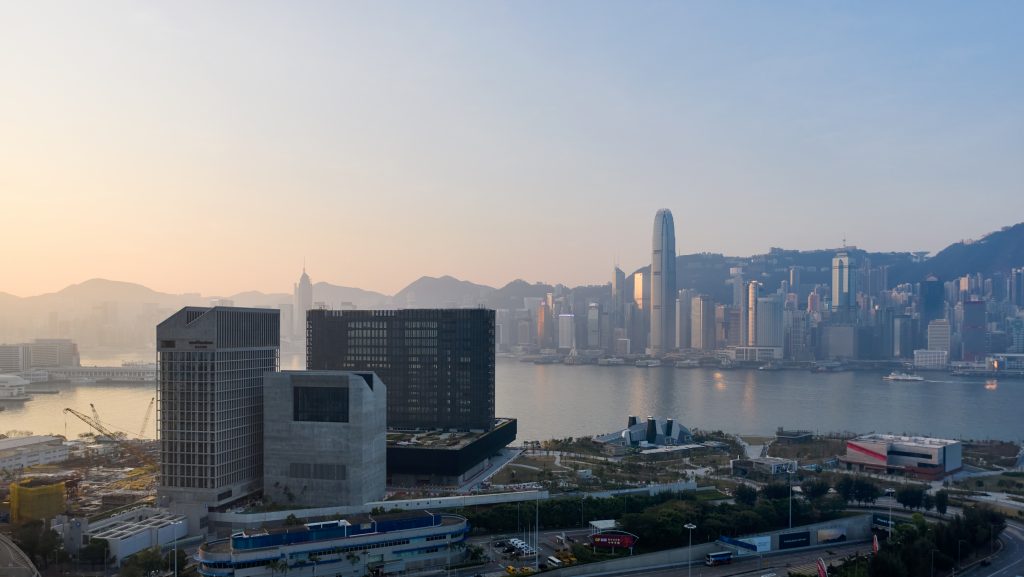
Behind the scenes of the story rocking Hong Kong's art world.

Vivienne Chow

When the M+ Sigg Collection was first unveiled in Hong Kong in 2016, some art aficionados joked that the show was a must-visit because some of the works it presented—which had been donated to the forthcoming M+ museum—might not actually be shown when the institution officially opened to the public.
What seemed like a joke five years ago is no longer amusing. Less than two weeks after the first media tour of the M+ building ahead of its long-awaited opening later this year, the institution released a statement on midnight on March 24 that it “has no plans to show [Ai] Weiwei’s artwork Study of Perspective: Tian’anmen (1997) at the opening exhibitions.”
The announcement came after a week of orchestrated criticism from the city’s pro-Beijing politicians and media outlets, who questioned whether works from the M+ collection, including the famous photograph of Ai raising a middle finger at Beijing’s Tiananmen Square, would violate the national security law implemented last summer by “spreading hatred against China.”
In the eyes of many arts practitioners and members of the public in Hong Kong, the situation represents yet another example of Beijing’s ever-tightening grip on the city’s freedoms. The news also raised the eyebrows of the international art community, which has long viewed M+ as an institution that would bridge Hong Kong, Asia, and the rest of the world.
“It was particularly my fear that those important and challenging works preserved for the future Chinese generations… and confided to M+ will end up buried in its vault… at best,” collector Alain Servais told Artnet News.
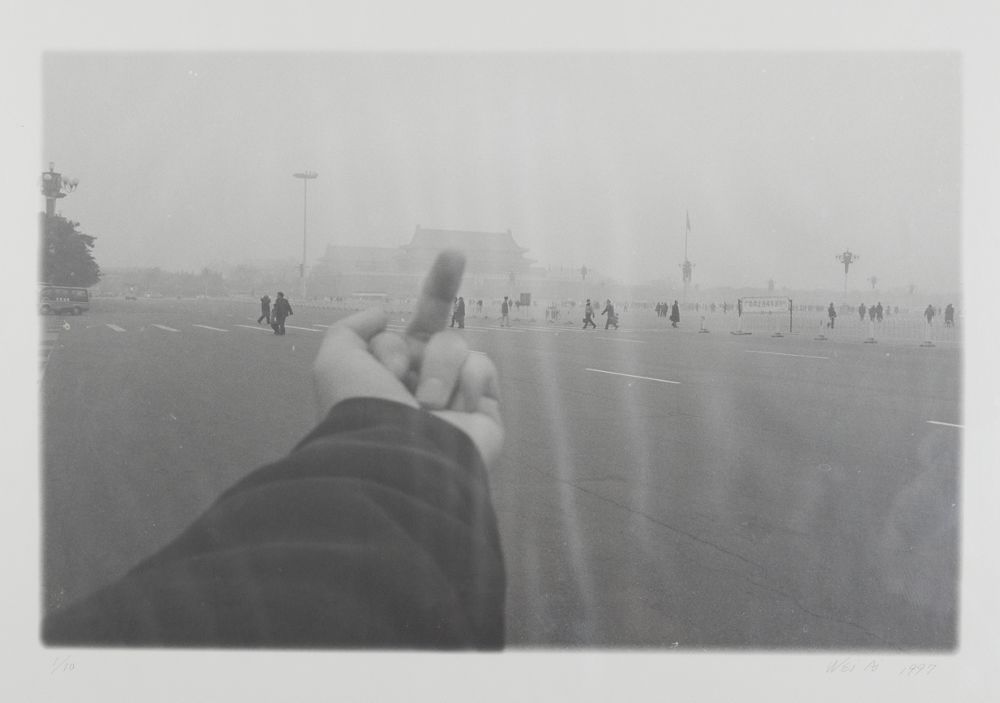
Ai Weiwei, Study of Perspective: Tian’anmen (1997). M+ Sigg Collection, Hong Kong. By donation, © Ai Weiwei.
The Ai Weiwei work under fire belongs to the famed collection donated by Uli Sigg, the Swiss former ambassador to China and an art-world heavyweight known for bringing Chinese contemporary art to global attention. It is part of a series in which the artist raised his middle finger at symbols of authority in cities from Washington, D.C. to Paris to Hong Kong.
In its March 24 statement, M+ noted that it houses nearly 8,000 items, including 1,510 works in the Sigg collection, and will show only a fraction of that total when it opens later this year. The final selection, a representative said, is based on the works’ “relevance to the theme and the context of the exhibitions.” Whether or not Ai’s work was intended for the inaugural display (the museum has maintained it was not), many observers viewed the statement as a concession to state pressure.
Attacks against M+ began when Hong Kong’s Chief Executive Carrie Lam, former chair of the board of the statutory body that runs West Kowloon Cultural District, where M+ is situated, was questioned by a pro-Beijing politician about the collection, and Ai’s work in particular, at a Legislative Council meeting following the museum’s press preview. She stressed that “we have to respect the freedom of artistic expression,” but added that the government “will be on full alert” to determine whether certain artworks would be “meant to incite hatred or to… undermine national security.”
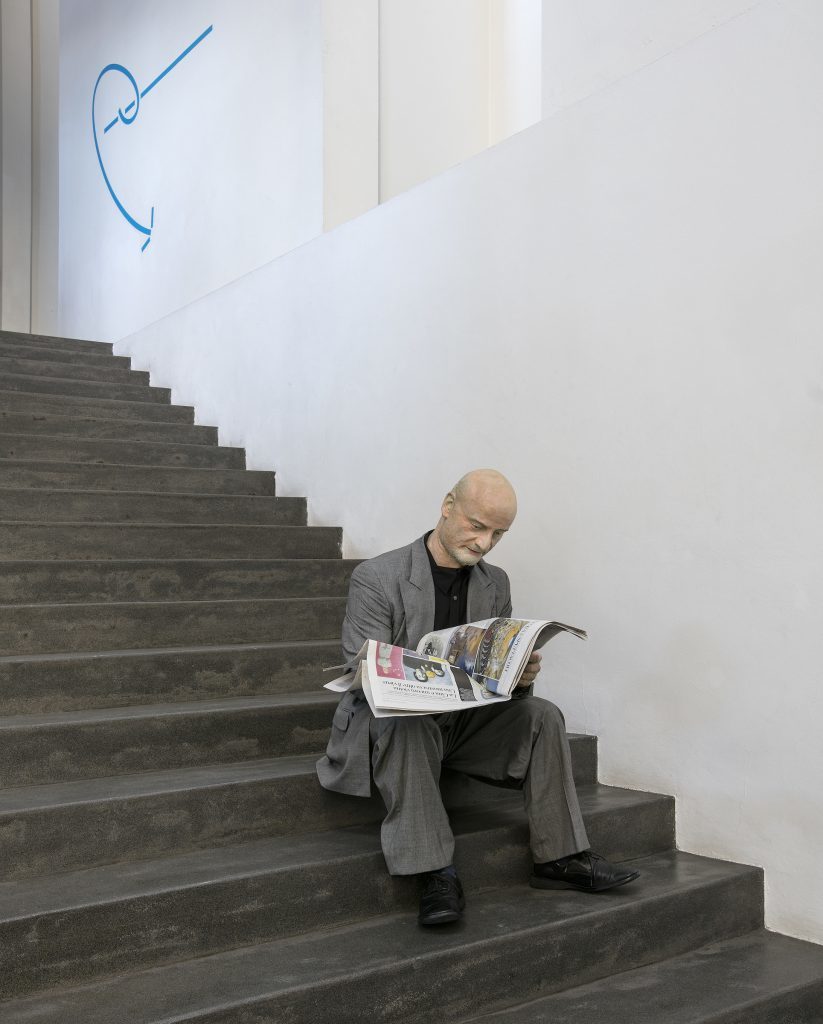
Installation view of “Facing the Collector. The Sigg Collection of Contemporary Art from China” at Castello di Rivoli.
Sigg himself has remained publicly silent about the controversy, but a statement he wrote to West Kowloon on March 23 was leaked on Monday to Hong Kong Citizen News. In it, he did not directly address the criticisms from Beijing loyalists, but instead spoke more broadly about the role of art.
“Contemporary art may be critical of reality, may even put a finger in the wound,” he wrote. “Contemporary art is not your good friend. It requires you to be open to the realities of this world and to have an interest in its analysis and critique… If you don’t work on this openness, you will not appreciate contemporary art.”
Sigg also emphasized that he sought to build an encyclopedic collection, not one shaped by his personal taste. It is a museum’s job, he wrote, to “mirror in an all-comprehensive manner the art production of the contemporary and experimental artists living in the PRC, along the time line [sic] and across all media.”
Sigg confirmed to Artnet News that he was the author of the statement and declined to comment further; the West Kowloon Cultural District declined to comment.
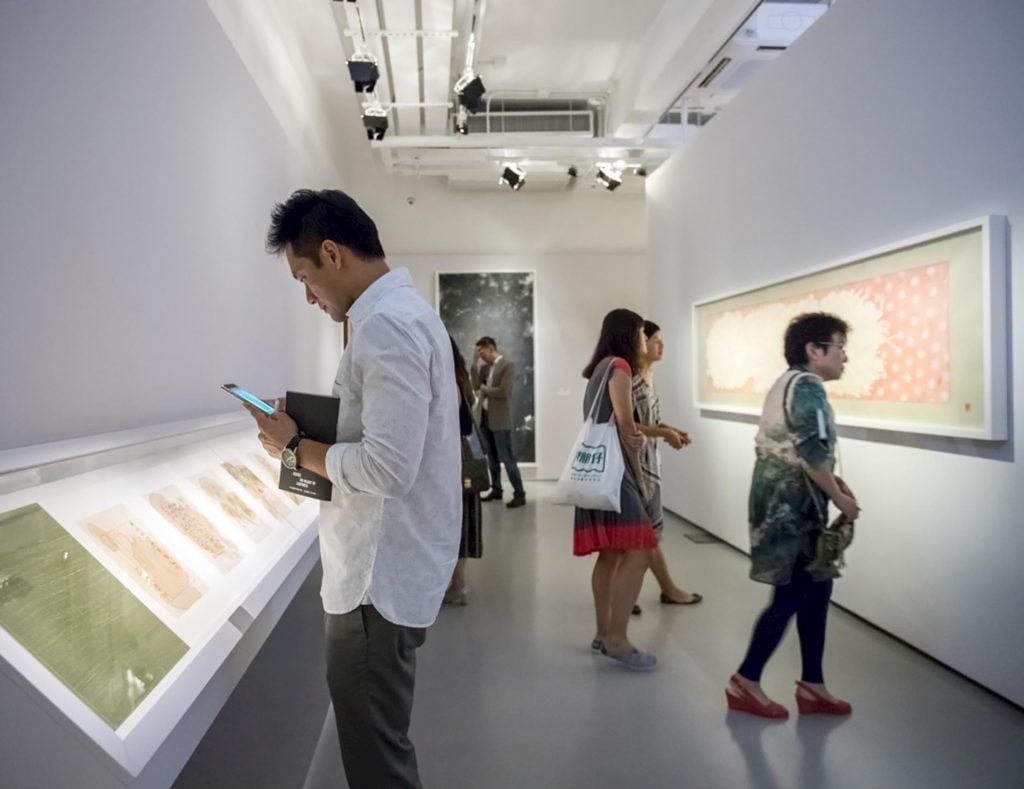
Visitors in the M+ event space. Courtesy of M+.
The uproar surrounding M+ ignited in mid-March, when more than 50 members of the press were invited for a sneak peek. There was a hint of excitement in the air. After years of delays due to construction issues, the building, which had an initial price tag of $759.4 million (HK$5.9 billion), was finally complete.
The space has all the trappings of an elite global contemporary art institution: a starchitect (Herzog & de Meuron, in partnership with TFP Farrells and Arup), a roof garden, a research center, a gigantic LED display on the facade to showcase new commissions, and even an underground space that resembles Turbine Hall at Tate Modern in London.
But M+ is facing a challenge its international peers are not: the scrutiny of the national security law. When asked about the presence of such politically sensitive works as Liu Heung-Shing’s photographs of the Tiananmen Massacre in 1989 (which were shown in the 2016 preview exhibition of Sigg’s collection) and others by Ai, the museum’s director Suhanya Raffel responded unequivocally. “No problem,” she said. “We will show those.”
“Weiwei is part of our collection. Our exhibitions and collections are developed with historic and academic facts around it, and that’s what we tend to show,” she told the media. “A city can only be a global arts hub if you offer a welcoming environment for the arts that reflect a wide range of perspectives and views… and here we have the first time a global museum in Hong Kong telling our stories in a way that has never been done before… [and] couldn’t have happened in other parts of Asia.”
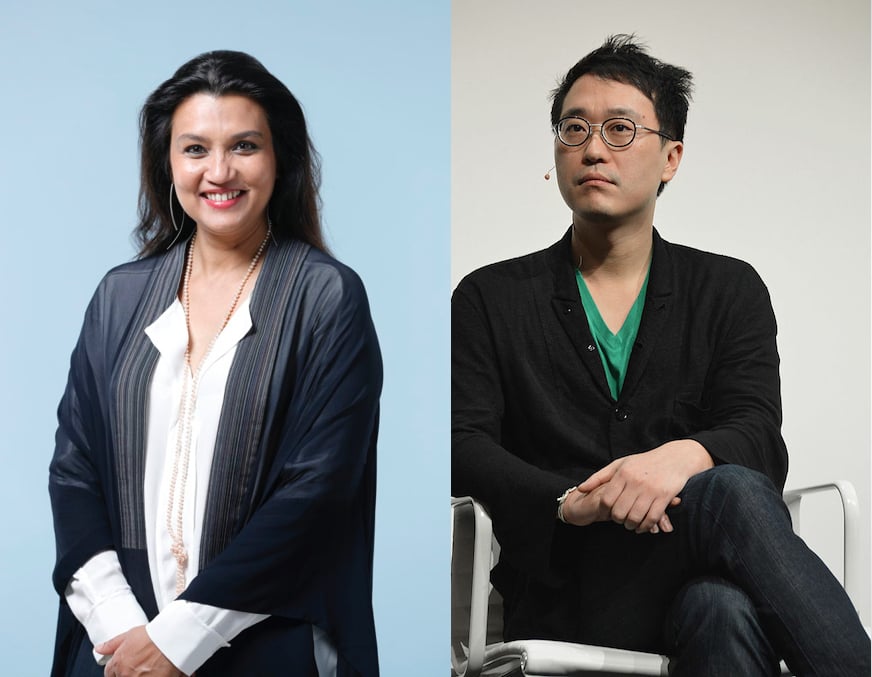
M+ executive director Suhanya Raffel and head curator Doryun Chong. Photo: Courtesy of West Kowloon Cultural District Authority/Getty Images.
It did not take long after that for M+ to become a target of the city’s pro-Beijing camp. The pressure began with a question, raised by New People’s Party’s lawmaker Eunice Yung, about whether Ai’s work would violate the national security law, which was passed by Beijing’s legislature last June and bans activities related to secession, terrorism, subversion of the state, and collusion with foreign influences to endanger national security. Around 100 people have been arrested under the law, including most pro-democracy legislators and activists.
In the days after the preview, front-page reports in pro-Beijing media attacked the museum’s lavish spending of public money on art; criticized its lack of transparency in making acquisitions; and questioned the value and decency of its collection. One report described the museum’s purchase, in 2016, of the entire body of work by pioneering conceptual artistic duo Young-Hae Chang Heavy Industries as “mind boggling,” alleging that these “so-called artworks” were “overpriced” and had little to do with Hong Kong.

Isaac Chong Wai, Rehearsal of the Futures: Police Training Exercises (2018). Documented at Blindspot Gallery, Hong Kong and commissioned by M+. Copyright Isaac Chong Wai.
Attacks on the Sigg collection were particularly prevalent, including suggestions that it contains indecent nude images and works that are disrespectful to state leaders, such as Shi Xinning’s painting Duchamp Retrospective Exhibition in China, a surreal depiction of Mao Zedong inspecting Marcel Duchamp’s Fountain. Zhang Xiaogang’s famed “Bloodline Series,” which has long been an auction favorite, also came under fire.
“There is no collection that celebrates China’s innovation and advances over the past 50 years as much as this one, and they are attacking it,” said one Hong Kong art-world insider. “They have no idea what they are doing, or what’s in this collection.”
Some key figures of the pro-Beijing camp have broken ranks to defend M+. Bernard Chan, convenor of the government’s Executive Council, the de facto cabinet of the chief executive, said government censorship of museums and galleries would “put us at risk of losing our global reputation” as a global art center.
Henry Tang, chair of the West Kowloon District Authority, told the media on March 29: “We have to ensure that this diversity and the freedom of expression as enshrined in the Basic Law [the city’s mini-constitution] to us as Hong Kong people is protected.”
What’s more, Tang said, if works in the collection, which are available online, were deemed in violation of the national security law, the police likely would have already approached M+—and so far, he said, they have not. Tang also rejected suggestions that M+’s statement about Ai Wiewei should be seen as a concession to pro-Beijing forces when the photograph in question was never intended to be part of the inaugural display. He declined to comment further on what will or will not be presented at the museum when it opens.
The attack on M+ is one of many recent incidents targeting cultural producers in Hong Kong. Pro-Beijing media also criticized the screenings of Inside the Brick Wall, suggesting that the film, which captures the standoff between the police and protesters at Polytechnic University in 2019, may violate the national security law despite the fact that it was approved by local censors with an 18+ rating. Cinemas subsequently cancelled all screenings.
Public broadcaster RTHK is also facing an overhaul after being criticized for “inadequacies” and reports on the 2019 protests allegedly “siding with protesters.” And on Monday, the city’s largest free-to-air broadcaster, TVB, confirmed it would not present this year’s Oscars for the first time since 1969. Although the company said it was a business decision, the move came after the mainland banned live coverage of the awards ceremony. Nominee Chloé Zhao, the Beijing-born director of the film Nomadland, has made comments critical of Beijing in the past, while Do Not Split, a documentary on Hong Kong’s 2019 protests, is competing for Best Documentary Short.
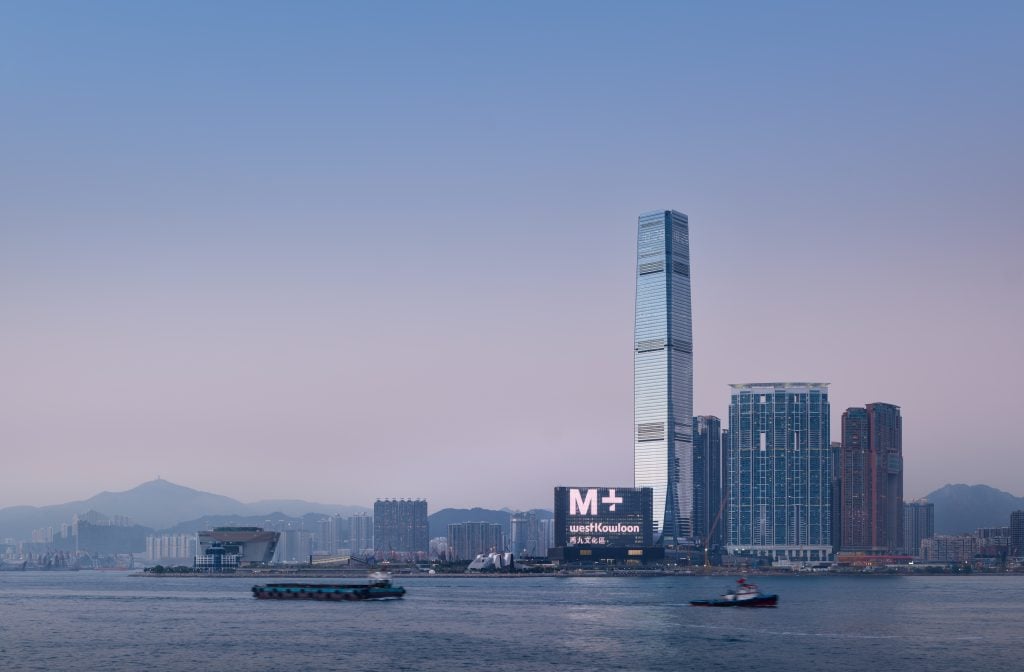
The new M+ museum seen across the Hong Kong skyline. Courtesy of M+.
The debates surrounding the Sigg collection are not entirely new. The 2012 acquisition—which included the donation of 1,463 Chinese contemporary artworks estimated to be worth $167 million (HK$1.3 billion) and the purchase of 47 works for $22.78 million (HK$177 million)—sparked criticism because of its focus on Chinese contemporary figures, particularly those favored by the west, in lieu of Hong Kong artists.
At the time, Sigg said he wanted his collection to be accessible to those in China, but considered Hong Kong the only place where his works could be shown freely.
“The early debates revolved around the museum’s intention and how much it detached itself from the local reality,” said Anthony Leung Po Shan, an artist and art critic in Hong Kong. “But over the years, I’m convinced by what they are doing and I understand why they do what they do.”
While government-run museums such as the Hong Kong Museum of Art and the Hong Kong Heritage Museum have vast collections of local art, M+ has a smaller proportion: around 20 percent of its 7,978-work strong collection. It has also seized every possible opportunity to remind the international art community of its presence, holding special tours for overseas visitors during Art Basel and organizing shows of homegrown artists abroad, including Hong Kong’s presentation at the Venice Biennale.
Despite its rocky entrance, the Sigg collection—and M+ more broadly—has been embraced by the local Hong Kong art community as a symbol of the city’s continued presence on the global stage. And this makes the uncertainty surrounding its future all the more anxiety-inducing.
“Although most of the museums are government-run, its establishment has been an integral part of the civil society. It is part of the public culture,” Leung said. “We are defending not just one museum [M+], but the system and its mandate. If it is under attack, what does it mean to our civil society and public culture?”